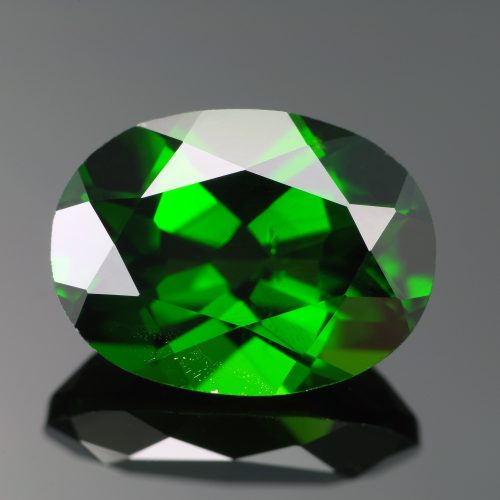
Diopside is part of the pyroxene group of gems. Considered a “collector” gem until relatively recently, it is available in green, yellow, and reddish-brown with cat’s-eye and star varieties from Myanmar and India respectively. Diopside did not even approach “jewelry stone” status until a rich discovery of large deposits of chrome diopside in Russia c. 1987. Previously chrome diopside, while desirable, was too scarce to be ma5rketed widely. Once the Russian strike hit the market, it quickly became a popular choice for lovers of rich green gemstones with a frugal pocketbook.
Chrome diopside is somewhat difficult to cut because of its cleavage planes and modest placement on the Mohs scale. Stones under two carats are primarily what make it to the marketplace, larger stones are often darker and subdued in appearance. Note that opal, a gem that’s long been a jewelry favorite, has the same hardness as chrome diopside. Like opal, with a moderate amount of caution, chrome diopside makes a beautiful gemstone choice.
Gemological Information for Diopside
| Color: | Bluish Green to Yellowish Green, Brown, Black |
| Crystal Structure: | Monoclinic |
| Refractive Index: | 1.729 - 1.768 |
| Durability: | Poor |
| Hardness: | 5.5 to 6 |
| Family: | Pyroxene Group |
| Similar Stones: | Peridot, Dioptase, Enstatite, Kornerupine, Zoisite |
| Treatments: | None Known at this Time |
| Country of Origin: | Myanmar, Sri Lanka, Republic of Madagascar, India, Finland, Russia, Afganistan. |
Diopside Care
| Ultrasonic Cleaning: | RIsky |
| Steam Cleaning: | Never |
| Warm Soapy Water: | Safe |
| Chemical Attack: | Attacked by Hydrofluoric Acid |
| Light Sensitivity: | Stable |
| Heat Sensitivity: | Fuses with Heat |
Sources
- Federman, David. Gem Profile/2: The Second Sixty. Shawnee Mission, KS: Modern Jeweler, A Vance Corporation Publication, 1992.
- Schumann, Walter. Gemstones of the World. New York: Sterling Publishing, Co., 1977.